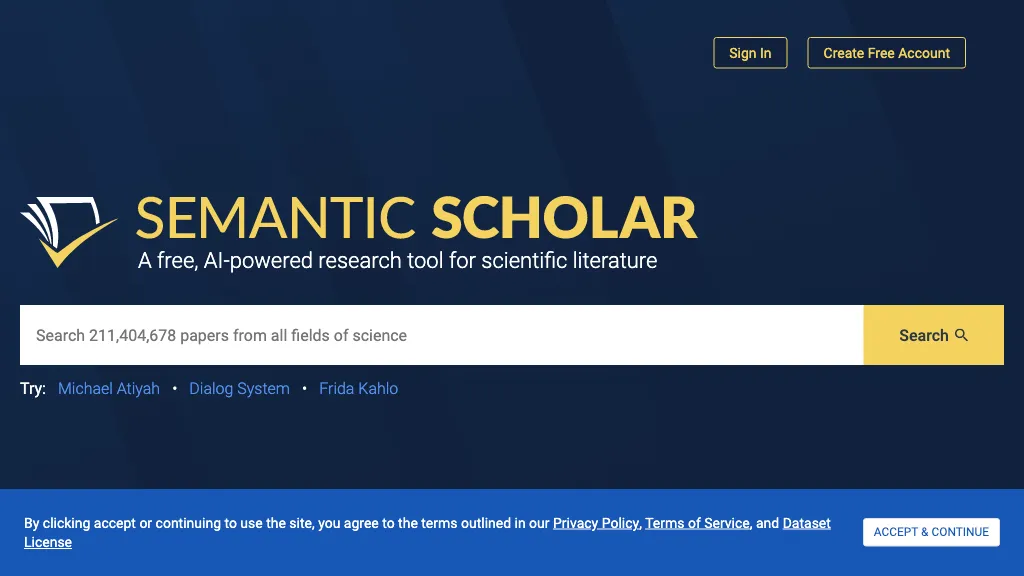What is Semantic Scholar?
Semantic Scholar is a free AI-driven academic research tool to drive complicated navigation through scientific literature. Driven by the Allen Institute for AI, Semantic Scholar offers free access to 211 million scientific papers and greatly accelerates literature searches and scientific reading. API is also available for developers building Scholar apps. Beta: Semant Reader to augment scientific reading.
Semantic Scholar Key Features & Benefits
Literature Search: It offers a huge database of scientific papers, aiding the user in finding studies related to his or her work more easily.
API for Developers: This feature provides the power to developers for building custom Scholar apps, adding more usability to the tool.
Scholar Apps: Applications are provided through Semantic Scholar, which helps scholars support their work in research.
Scientific Reading Augmentation: The beta version of the Semant Reader adds value to a researcher’s reading by underlining key insights and relations across different pieces of work.
AI-powered Research Tool: This uses advanced AI algorithms in order to filter and prioritize research papers on relevance and impact.
Major benefits that one can get from using Semantic Scholar include increased research efficiency, access to a big repository of scientific papers, and the availability of advanced tools for literature analysis. What makes this tool truly different from all other research tools out there is its unparalleled capacity to unveil hidden meanings and connections within academic publications.
Semantic Scholar Use Cases and Applications
Many factors make Semantic Scholar invaluable for the following reasons:
- Efficient Literature Review: Semantic Scholar helps researchers and academics conduct thorough literature reviews in a minimum amount of time and with greater efficiency.
- Development of Scholar Apps: API helps build custom applications to aid scholarly research.
- Scientific Augmented Reading: Semant Reader enhances reading by providing insight through creative visualizations and summaries.
Other beneficiaries of Semantic Scholar include academia, scientific research, and any other industry that relies on thorough literature searches. Primary end-users include researchers, scientists, academics, and students.
Using Semantic Scholar
Access to the Platform: Login into Semantic Scholar.
Paper Searching: The platform allows a user to key in keywords or topics of interest via a search bar.
Filter Results: Use filters to prioritize results provided by relevance, date of publication, among many other features.
Paper Analysis: Summaries, visualizations, and citation analysis are provided for each paper.
API: Developers can use the API to create custom applications that integrate with Semantic Scholar.
For best practices in using the tool, have at hand notifications for updates or the inclusion of new features because the platform is under continuous evolution for better service delivery to its users.
How Semantic Scholar Works
Semantic Scholar uses advanced AI algorithms which process and analyze large volumes of scientific literature. The platform gives meaning to research papers by using natural language processing and machine learning. This helps it gain meaningful insights from the texts and pinpoint relations between data items, often hidden to the naked eye.
It indexes millions of scientific papers, analyzes their content, and delivers to the users the most relevant and impactful studies based on the requirements specified by the users. Apart from that, the platform provides users with various forms of visualizations and citation analyses relating to the broader context of their topics.
Semantic Scholar Pros and Cons
Following are some of the advantages of using Semantic Scholar:
- Comprehensive Database: Access to more than 211 million scientific papers.
- AI-driven insights are advanced by algorithms, applicable relevant research findings.
- Free access: the platform is free, thus accessible to a wide range of users.
The following are some potential disadvantages:
- Beta features: some features like the Semant Reader will always remain in beta and never be fleshed out.
- Learning curve: it might take some time for the newcomers to get used to how features work or where they are located.
In general, user feedback tends to refer to efficiency in the platform and insight quality; but for some users, beta features still do need a bit more polish.
Conclusion about Semantic Scholar
In a nutshell, Semantic Scholar is a fast, AI-driven research tool whose presence largely enhances scientific literature searching in terms of efficiency and effectiveness. Its rich database, along with advanced algorithms and user-friendly features, makes it an integral component in the work of a researcher, scientist, or academic. Further developments and updates are foreseen, which should give even more value to the platform.
Semantic Scholar FAQs
Q1. Is Semantic Scholar free?
Yes, the use of Semantic Scholar is completely free.
What type of literature am I able to find on Semantic Scholar?
Use the platform to access over 211 million scientific papers across all topics and disciplines.
How does Semantic Scholar rank the search results?
The service employs AI algorithms of a high level to filter and show only papers by relevance and impact.
Is there an opportunity to create custom applications with Semantic Scholar?
Yes, the developer can develop their own customized apps for Scholar by using the provided API.
What is Semant Reader?
Semant Reader is a beta feature of scientific reading which emphasizes main insights and relations in scientific papers.










